Introduction
Budgerigars, affectionately known as budgies, are vibrant and sociable birds that make wonderful pets. However, like all pets, they can suffer from various health problems. Understanding common budgerigar diseases and how to prevent them is essential for keeping your feathered friend healthy and happy. In this blog post, we will explore the most common budgie health issues, the symptoms to watch for, and the best practices for preventing these diseases. By staying informed and proactive, you can ensure your budgie enjoys a long, healthy life.
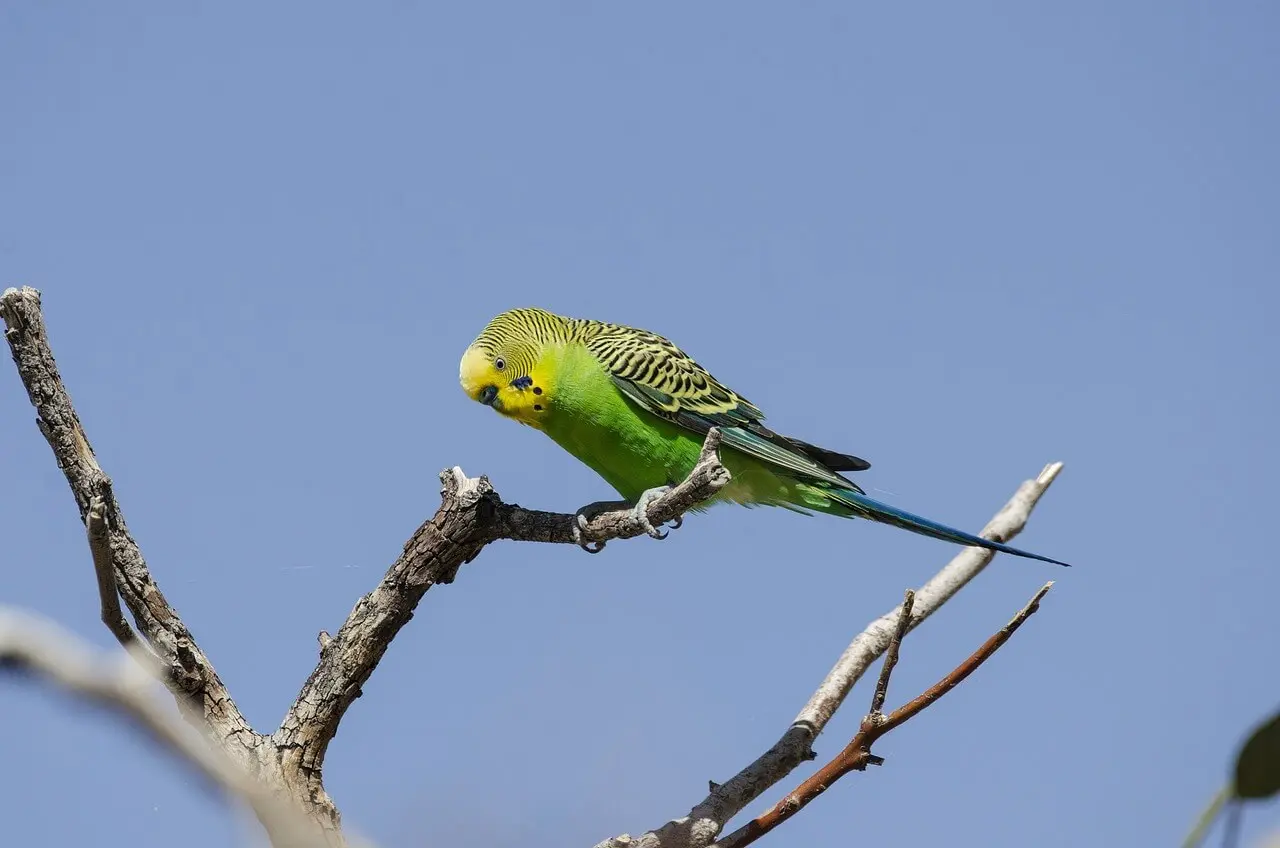
A vibrant budgerigar demonstrates typical alert behavior in the wild—key to monitoring bird health.
Budgerigar diseases can range from respiratory infections to parasitic infestations, and recognizing the signs early can make a significant difference in treatment outcomes. We’ll cover everything from the causes and symptoms of these illnesses to effective prevention and treatment strategies. Whether you’re a new budgie owner or have been caring for these charming birds for years, this guide will provide you with valuable insights to maintain your budgie’s health.
By incorporating regular vet check-ups, maintaining a clean living environment, and providing a balanced diet, you can significantly reduce the risk of budgie health problems. Additionally, understanding the importance of quarantine for new birds can prevent the spread of diseases within your flock. With the right knowledge and care, you can create a safe and nurturing environment for your budgerigar.
So, let’s dive in and learn about the common diseases that affect budgerigars and how you can keep your pet bird in top shape. From identifying early warning signs to implementing preventive measures, we’ve got you covered. Let’s ensure your budgie remains a lively and healthy companion for years to come.
Understanding Budgerigar Health
Understanding budgerigar health is crucial for any bird owner. These small, colorful birds are generally hardy, but they can still fall prey to various budgerigar diseases. Recognizing the signs of illness early and taking preventive measures can help ensure your budgie stays in top condition.
Budgerigars, like all birds, have specific health needs. Their diet, environment, and general care all play a significant role in preventing common budgie health problems. A balanced diet rich in seeds, fruits, and vegetables provides essential nutrients that keep your budgie’s immune system strong. Clean, fresh water is also vital for their overall health.
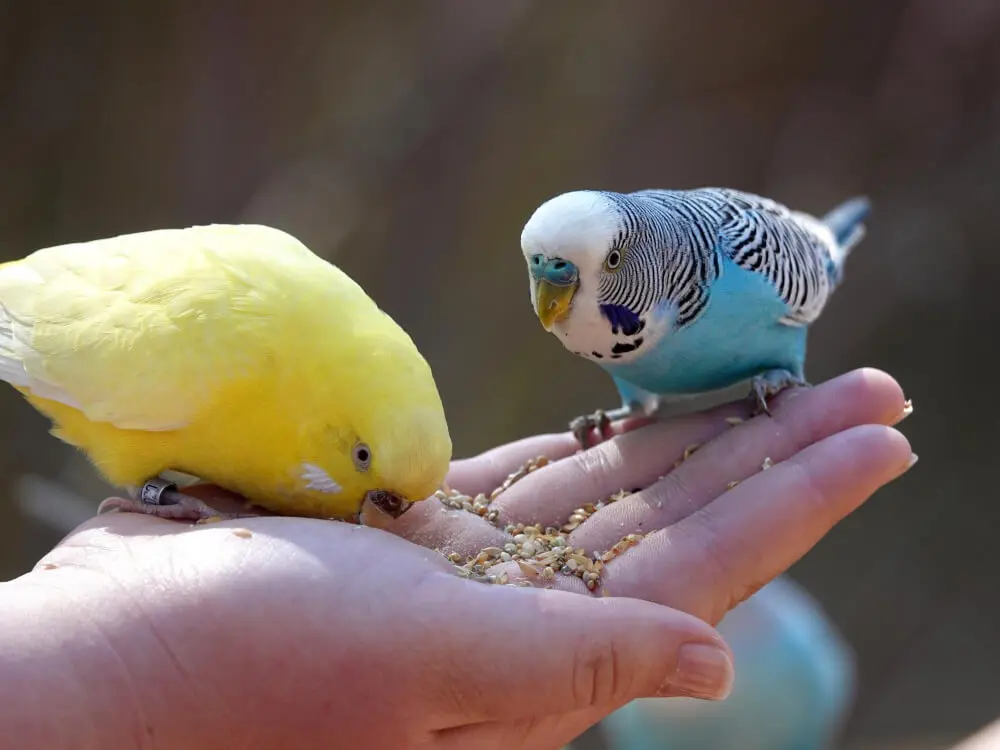
Balanced diet practices in hand-feeding budgerigars for optimal health.
Regular vet check-ups are an essential part of budgie health care. A knowledgeable avian vet can spot potential health issues before they become serious problems. Routine visits can help in early detection of diseases, making treatment more effective and less stressful for your bird.
The environment your budgerigar lives in also impacts their health. A clean, spacious cage with safe toys and perches can prevent injuries and reduce stress. Daily cleaning of the cage helps prevent the build-up of harmful bacteria and parasites. Additionally, ensure your budgie has plenty of natural light and fresh air, but avoid direct drafts or extreme temperatures.
Another key aspect of budgerigar health is quarantine. When introducing a new bird to your home, it’s essential to keep them separate from your existing birds for at least 30 days. This practice helps prevent the spread of any potential diseases and allows you to monitor the new bird for any signs of illness.
Understanding the basics of budgerigar health, from diet and environment to regular vet visits and quarantine, can make a big difference in preventing diseases. By taking these steps, you can ensure your budgie leads a healthy, happy life.
Common Budgerigar Diseases
Budgerigars, despite being generally resilient, can still be affected by a range of health issues. Knowing about common budgerigar diseases helps you catch early signs and take appropriate action. Let’s explore some of the most frequent illnesses that can affect your budgie and how to recognize them.
Respiratory Infections
Causes and Symptoms
Respiratory infections in budgerigars are commonly caused by bacteria, viruses, or fungi. Symptoms include sneezing, coughing, nasal discharge, wheezing, and difficulty breathing. Budgies might also exhibit tail bobbing, where their tail moves up and down with each breath.
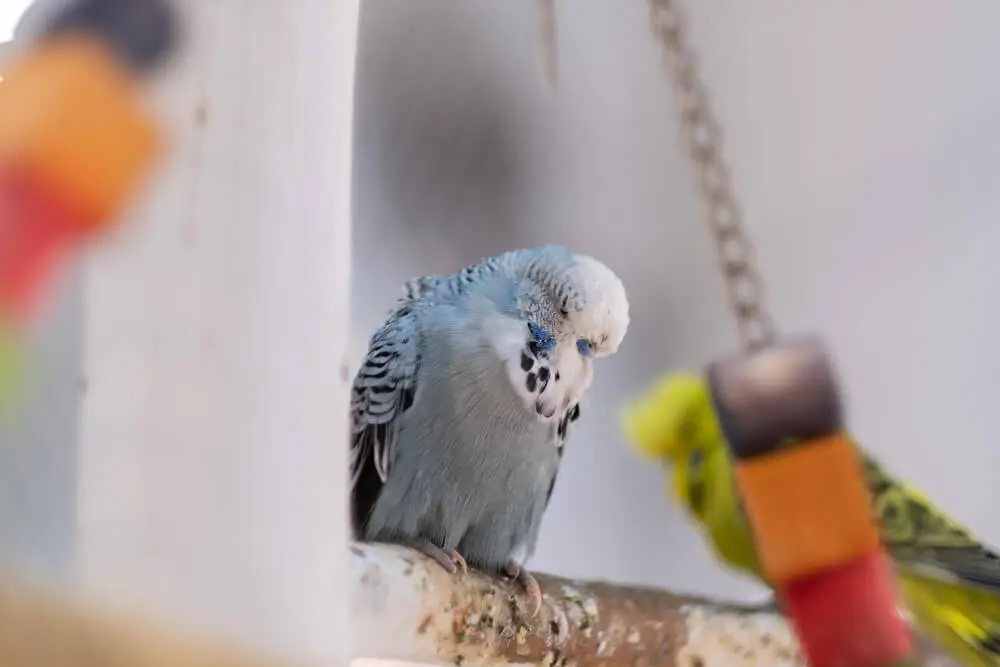
Recognizing the signs of illness in a budgerigar is crucial for timely care.
Prevention and Treatment
To prevent respiratory infections, ensure your budgie’s environment is clean, free of drafts, and well-ventilated. Regular cage cleaning and avoiding exposure to smoke or strong odors can also help. If your budgie shows symptoms, consult an avian vet immediately. Treatment may involve antibiotics, antivirals, or antifungals, depending on the cause.
Psittacosis (Parrot Fever)
Causes and Symptoms
Psittacosis, also known as parrot fever, is a bacterial infection caused by Chlamydia psittaci. Symptoms include lethargy, loss of appetite, ruffled feathers, watery green droppings, and respiratory distress. This disease can be transmitted to humans, so prompt diagnosis and treatment are critical.
Prevention and Treatment
Prevent psittacosis by maintaining good hygiene and regular vet check-ups. Isolate new birds for at least 30 days to monitor for symptoms. Treatment typically involves a course of antibiotics prescribed by a vet. Early detection and strict hygiene practices are key to managing this disease.
Avian Gastric Yeast (AGY) Infection
Causes and Symptoms
Avian Gastric Yeast (AGY) infection, or megabacteriosis, is a fungal infection that affects a budgie’s digestive system. Symptoms include weight loss, regurgitation, and undigested seeds in droppings. Budgies may also appear fluffed up and lethargic.
Prevention and Treatment
To prevent AGY, ensure your budgie’s diet is balanced and their living environment is clean. If your budgie shows symptoms, consult an avian vet for diagnosis and treatment, which typically involves antifungal medications. Regular health check-ups can help catch infections early.
Budgerigar Tumors
Causes and Symptoms
Tumors in budgerigars can be either benign or malignant and are more common in older birds. Symptoms include visible lumps, weight loss, lethargy, and changes in droppings. Tumors can occur internally or externally.
Prevention and Treatment
While there’s no sure way to prevent tumors, regular vet check-ups can help detect them early. If you suspect your budgie has a tumor, seek veterinary care immediately. Treatment options may include surgery, medication, or supportive care depending on the type and location of the tumor.
Scaly Face and Leg Mites
Causes and Symptoms
Scaly face and leg mites are caused by microscopic parasites that burrow into a budgie’s skin, leading to scaly growths around the beak, eyes, and legs. Affected budgies might also scratch frequently and show signs of discomfort.
Prevention and Treatment
Prevent mite infestations by keeping your budgie’s environment clean and quarantining new birds. If you notice signs of mites, consult a vet for antiparasitic treatment. Regularly clean and disinfect the cage and accessories to prevent re-infestation.
Feather Plucking
Causes and Symptoms
Feather plucking is a behavioral issue often caused by stress, boredom, or underlying medical conditions. Budgies may pull out their feathers, leading to bald patches and potential skin infections.

Identifying and managing stress-related behaviors like feather plucking in budgerigars.
Prevention and Treatment
Address the root cause of feather plucking by improving the environment, reducing stress, and providing mental stimulation with toys and interaction. Consult a vet to rule out medical issues. Ensuring your budgie has a stimulating and stress-free environment can help curb this behavior.
Candidiasis
Causes and Symptoms
Candidiasis is a fungal infection caused by the yeast Candida, often affecting the digestive tract of budgerigars. Symptoms include a white, cheesy substance in the mouth, vomiting, diarrhea, and a lack of appetite. Young birds and those with weakened immune systems are more susceptible.
Prevention and Treatment
Prevent candidiasis by maintaining a clean environment and providing a balanced diet. Avoid overuse of antibiotics, which can disrupt the natural balance of yeast in the gut. If your budgie shows symptoms, consult an avian vet. Treatment typically involves antifungal medications and supportive care.
Polyomavirus
Causes and Symptoms
Polyomavirus is a viral infection that can be particularly severe in young budgerigars. Symptoms include feather abnormalities, lack of appetite, lethargy, and sudden death in severe cases. Adult birds may be asymptomatic carriers.
Prevention and Treatment
Prevent polyomavirus by practicing good hygiene, quarantining new birds, and avoiding overcrowding. There is no specific treatment for polyomavirus, so supportive care and preventing the spread of the virus are essential. Vaccination is available in some regions and can help protect against the virus.
Egg Binding
Causes and Symptoms
Egg binding occurs when a female budgerigar is unable to pass an egg, which can be life-threatening. Symptoms include straining, lethargy, swelling around the abdomen, and difficulty breathing.
Prevention and Treatment
Prevent egg binding by ensuring a balanced diet rich in calcium and providing proper nesting conditions. If you suspect egg binding, seek veterinary care immediately. Treatment may involve gentle manipulation, medication, or surgery in severe cases.
Fatty Liver Disease (Hepatic Lipidosis)
Causes and Symptoms
Fatty liver disease, or hepatic lipidosis, occurs when excess fat accumulates in the liver. Symptoms include obesity, lethargy, abdominal swelling, and yellowing of the skin or beak.
Prevention and Treatment
Prevent fatty liver disease by feeding a balanced diet with limited fatty seeds and plenty of fruits and vegetables. Encourage exercise by providing ample space for your budgie to fly and play. If diagnosed, treatment involves dietary changes and supportive care as recommended by a vet.
Understanding these common budgerigar diseases and their symptoms is the first step in ensuring your budgie’s health. Early detection and proper care can make a significant difference in treatment outcomes. Always consult with an avian vet if you notice any signs of illness in your budgie. By staying informed and proactive, you can help your budgie live a long, healthy life.
How to Prevent Budgerigar Diseases
Recognizing Signs of Illness Early
Recognizing signs of illness early in budgerigars is crucial for timely intervention and treatment. By staying observant and aware of your budgie’s normal behavior and appearance, you can detect health issues before they become severe. Here are key indicators to watch for in your feathered friend.
Behavioral Changes
Budgerigars are active and social birds, so any significant change in their behavior can be a red flag. Here are some behavioral signs that may indicate illness:
- Lethargy: If your normally active budgie becomes unusually quiet and inactive, it could be a sign of illness.
- Changes in Vocalization: A sudden decrease in chirping or a change in the tone of their vocalizations can indicate that something is wrong.
- Decreased Appetite: If your budgie is eating less than usual or seems uninterested in food, it could be a sign of a health issue.
- Hiding or Avoiding Interaction: Budgies that are feeling unwell may hide or avoid interaction with you or other birds.
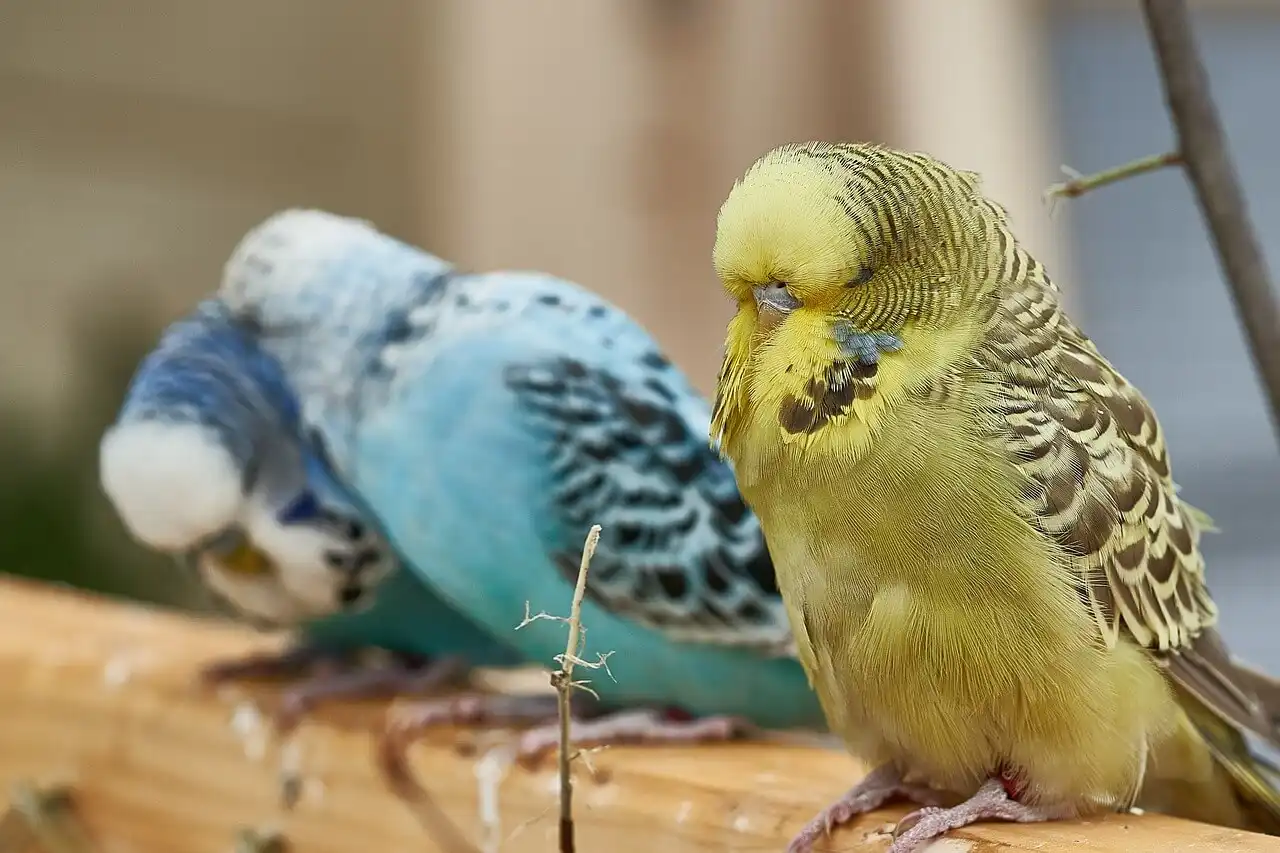
Monitoring budgerigars for signs of lethargy which can indicate health issues.
Physical Symptoms
In addition to behavioral changes, there are several physical symptoms that can signal a problem:
- Changes in Droppings: Healthy budgie droppings are firm and have a white part (urates) and a green or brown part (feces). Watery, discolored, or unusually frequent droppings can indicate an issue.
- Weight Loss: Regularly weigh your budgie to monitor their weight. Sudden or gradual weight loss can be a sign of underlying health problems.
- Feather Plucking: While feather plucking can be behavioral, it can also indicate skin infections, parasites, or other health issues.
- Respiratory Issues: Look for signs like tail bobbing, wheezing, coughing, or nasal discharge. These can indicate respiratory infections or other illnesses.
- Changes in Eyes and Beak: Dull or sunken eyes, discharge, or changes in the beak’s appearance can also signal health problems.
When to See a Vet
If you notice any of these signs, it’s essential to consult an avian vet as soon as possible. Early diagnosis and treatment can make a significant difference in the outcome. Regular check-ups, even when your budgie appears healthy, can also help catch issues early.
Monitoring Your Budgie’s Health
Consistently monitoring your budgie’s behavior and physical condition is key to early illness detection. Keep a journal of any changes you observe, no matter how minor they may seem. This record can be invaluable to your vet in diagnosing and treating potential health problems.
By recognizing signs of illness early, you can ensure your budgerigar receives the prompt medical attention they need. Staying vigilant and responsive to changes in your budgie’s behavior and appearance will help keep them healthy and happy. Remember, a proactive approach to budgerigar health is the best way to prevent and manage diseases.
Conclusion
Keeping your budgerigar healthy requires a proactive approach and a keen eye for potential health issues. By understanding common budgerigar diseases and implementing preventive measures, you can significantly reduce the risk of illness in your feathered friend.
A balanced diet, clean living environment, regular vet check-ups, and proper quarantine practices are essential in maintaining your budgie’s health. Recognizing early signs of illness—such as behavioral changes and physical symptoms—allows for timely intervention and better treatment outcomes.
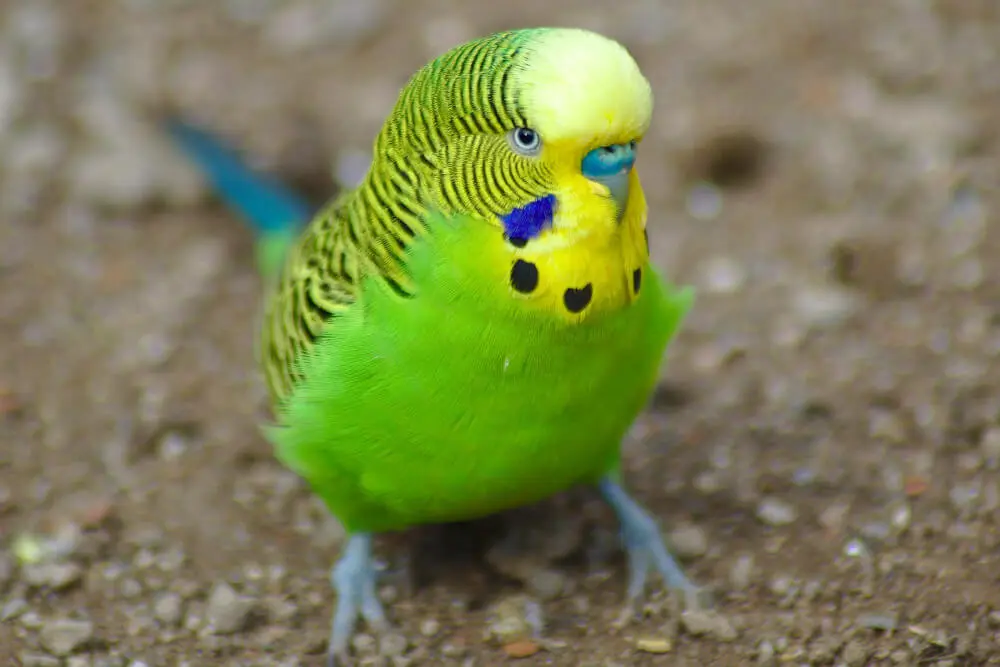
Active and alert behaviors as indicators of a healthy budgerigar.
Your budgerigar depends on you for their well-being, and being informed about budgie health can help you provide the best care possible. Regularly observe your budgie, stay updated on best practices for their care, and consult your avian vet with any concerns. With the right knowledge and attention, you can ensure your budgie leads a long, healthy, and happy life.
By following the tips and guidelines outlined in this post, you’ll be well-equipped to prevent budgerigar diseases and address any health issues promptly. Your commitment to your budgie’s health will pay off with a vibrant, active, and joyful pet.
FAQs
What are the most common diseases in budgerigars?
Common budgerigar diseases include respiratory infections, Psittacosis (Parrot Fever), Avian Gastric Yeast (AGY) infection, tumors, scaly face and leg mites, feather plucking, candidiasis, polyomavirus, egg binding, and fatty liver disease. Recognizing the symptoms and seeking early veterinary care can help manage and treat these conditions effectively.
How can I tell if my budgerigar is sick?
Signs of illness in budgerigars can include behavioral changes like lethargy, decreased appetite, and hiding. Physical symptoms to watch for include changes in droppings, weight loss, feather plucking, respiratory issues, and changes in the eyes or beak. Regularly monitoring your budgie’s health and consulting a vet at the first sign of illness is crucial.
What should I do if my budgerigar shows signs of illness?
If your budgerigar shows signs of illness, it’s important to consult an avian vet immediately. Early intervention can make a significant difference in treatment outcomes. Isolate the sick bird from others to prevent the spread of disease and follow your vet’s advice on care and treatment.
How often should I take my budgerigar to the vet?
It’s recommended to take your budgerigar to the vet at least once a year for a routine check-up. Regular vet visits help catch potential health issues early. If you notice any changes in your budgie’s behavior or appearance, schedule a vet visit immediately to address any concerns promptly.
How can I prevent budgerigar diseases?
Preventing budgerigar diseases involves providing a balanced diet, maintaining a clean living environment, and scheduling regular vet check-ups. Quarantine new birds for at least 30 days before introducing them to your existing flock. Recognize early signs of illness and consult your vet with any concerns to ensure your budgie stays healthy.
Is it necessary to quarantine new birds?
Yes, quarantining new birds for at least 30 days is essential to prevent the spread of diseases to your existing budgerigars. This period allows you to monitor the new bird for any signs of illness and seek veterinary care if needed, ensuring the health and safety of your entire flock.
Can budgerigars transmit diseases to humans?
Yes, certain diseases, such as Psittacosis (Parrot Fever), can be transmitted from budgerigars to humans. It’s important to practice good hygiene, regularly clean your budgie’s cage, and wash your hands after handling your bird to reduce the risk of transmission.
What should I feed my budgerigar to prevent diseases?
A balanced diet for a budgerigar should include high-quality seeds, fresh fruits, and vegetables. Avoid feeding an all-seed diet as it can lead to nutritional deficiencies. Offer a variety of foods like leafy greens, carrots, apples, and berries to ensure they receive essential nutrients.
How do I clean my budgerigar’s cage properly to prevent diseases?
To clean your budgerigar’s cage, remove droppings, uneaten food, and debris daily. Disinfect the cage and accessories weekly using a bird-safe cleaner. Replace the cage liner regularly and provide fresh water and food daily to maintain a hygienic environment.
What are some signs that my budgerigar might have a respiratory infection?
Signs of respiratory infection in budgerigars include sneezing, coughing, nasal discharge, wheezing, and difficulty breathing. If you notice any of these symptoms, consult an avian vet immediately for diagnosis and treatment.
How can I prevent scaly face and leg mites in my budgerigar?
Prevent scaly face and leg mites by keeping your budgie’s environment clean and quarantining new birds. Regularly clean and disinfect the cage and accessories, and consult a vet if you notice any signs of mites.
What should I do if my budgerigar has feather plucking issues?
Feather plucking can be caused by stress, boredom, or underlying medical conditions. Address the root cause by improving the environment, reducing stress, and providing mental stimulation with toys and interaction. Consult a vet to rule out medical issues and get appropriate treatment.
How do I recognize signs of fatty liver disease in my budgerigar?
Signs of fatty liver disease include obesity, lethargy, abdominal swelling, and yellowing of the skin or beak. Regularly monitor your budgie’s weight and consult a vet if you notice any of these symptoms.
What are the symptoms of Psittacosis in budgerigars and how is it treated?
Symptoms of Psittacosis include lethargy, loss of appetite, ruffled feathers, watery green droppings, and respiratory distress. Treatment typically involves a course of antibiotics prescribed by a vet. Early detection and strict hygiene practices are key to managing this disease.


